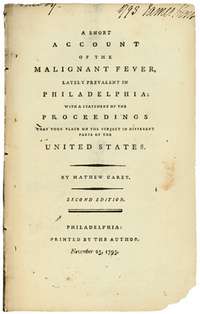A Short Account of the Malignant Fever

A Short Account of the Malignant Fever (1793) was a pamphlet published by Mathew Carey (January 28, 1760 – September 16, 1839) about the actions of African Americans during the Yellow Fever Epidemic of 1793 in Philadelphia in the United States. He accused blacks of causing the epidemic and of taking advantage of victims while acting as nurses.
His pamphlet was reprinted four times, widely distributed and contributed to fears and hostility in the city. Members of the Free African Society had risked their lives as nurses and aides to the sick and dying.
Background
The city of Philadelphia, the largest city and temporary capital of the United States, suffered a severe yellow fever epidemic in 1793, likely brought by immigrant refugees and ships from Saint-Domingue, where the disease was prevalent and a slave uprising was underway. The city had nearly 50,000 residents and was a major port on the Delaware River. It was also the seat of the state government.
During that time, Carey, along with many others who had the means, fled the city for weeks to try to escape the disease. The city had a large free black population of 2,000, which in 1787 had established its first mutual aid society, the Free African Society. It was organizing the first two independent black congregations in the city, each of which opened their churches the following year.
In his pamphlet, Carey accused the blacks directly of causing and spreading the disease and of invading the houses of the sick and dying to steal from them.[2] This seventeen-chapter pamphlet was widely distributed. He printed four editions, each one developed one step further from the previous one.
The epidemic in Philadelphia began in July 1793. This was the first major American yellow fever epidemic since the 1760s. It continued into October, with increasing victims each week.
The city had attracted many French-speaking immigrants and refugees from Saint-Domingue, both whites and their slaves, and free people of color.
Thomas Jefferson wrote to James Madison in the beginning of September, advising him of the disaster the epidemic would cause throughout the city. At the time, the population of Philadelphia was about 45,000. (Other estimates are 50,000.) Of the residents, an estimated 17,000 were said to have been ill, and nearly 5,000 died.[3]
According to numerous scholars, Dr. Benjamin Rush wrote to Richard Allen, a black preacher and leader of the Free African Society, appealing to him and his people for help. Rush believed that blacks might have immunity to the disease, as he had read accounts by another doctor of a yellow fever in epidemic in Charleston, in which they were reported as surviving at higher rates than whites. He appealed to Allen for aid in the epidemic.[4]
References
- ↑ Mathew Carey, A Short Account of the Malignant Fever which Prevailed in Philadelphia, 1793, William Reese Company, commercial site, photo of pamphlet cover
- ↑ Mathew Carey, A Short Account of the Malignant Fever which Prevailed in Philadelphia, 1793 (Philadelphia, 1793), 13-28, 65-68, 83-92, partial text hosted at University of Oregon MJ Dennis class site
- ↑ "Yellow fever", Harvard University
- ↑
External links
- Mathew Carey, A Short Account of the Malignant Fever which Prevailed in Philadelphia, 1793 (Philadelphia, 1793), 13-28,65-68,83-92, original document, hosted at University of Oregon.